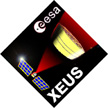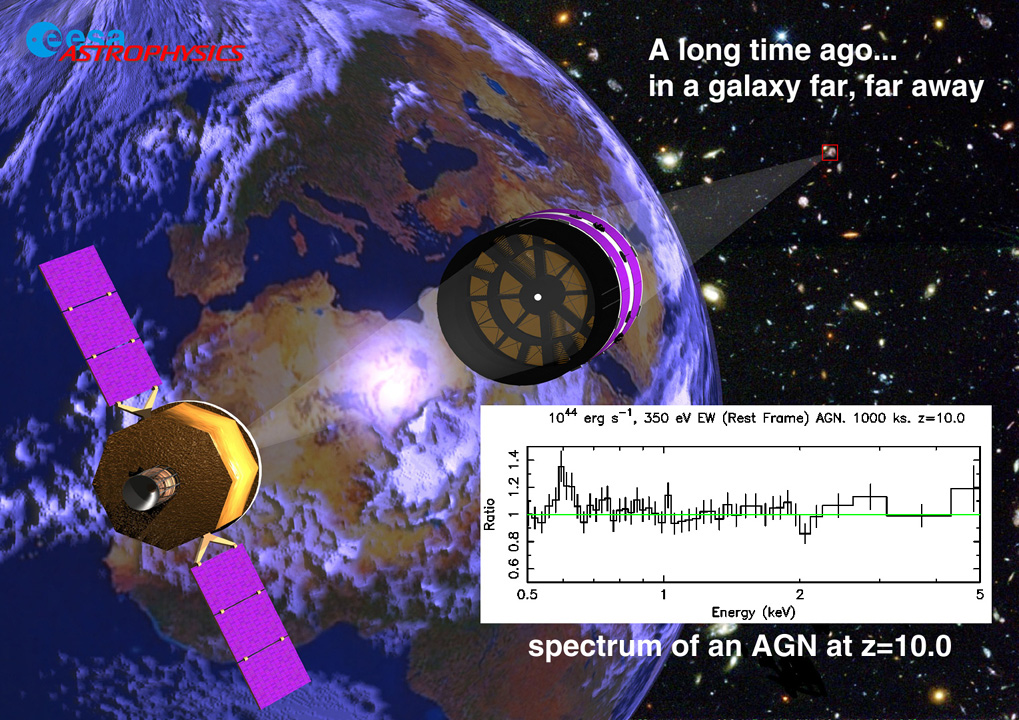XEUS, the "X-ray Evolving Universe Spectroscopy Mission", is being proposed as a permanent X-ray observatory in space providing a telescope aperture equivalent to the largest ground-based optical telescopes. It would consist of two free-flying spacecraft in low-Earth orbit (600 km), one carrying the X-ray mirror optics, the other with the science detectors. They would be launched together by an Ariane-5, nominally at the end of the next decade. Over the following years, XEUS would join the International Space Station (ISS) for refurbishment and to increase the telescope's capabilities. In their deployed configuration, the mirror and detector spacecraft would "fly in formation", 50 metres apart. The detector spacecraft would move following the orientation of the mirror spacecraft, but maintaining its relative position to ensure a perfect focus - to within +/- 1 mm3 using a laser range finder. XMM X-ray mirror technology, where Europe today leads the field, is at the heart of this follow-on mission. Employing the replication process developed by XMM teams with Zeiss and Media Lario, the satellite bearing the Wolter-1 optics would initially have a 6 m2 (at1 keV) collecting area of golden mirrors with a 4.5 m diameter, consisting of segments or "petals". After an initial 4-6 years in orbit, XEUS satellites would rendezvous with the ISS to allow the addition of a further ring of mirror petals, increasing the outer diameter to 10 m and the collecting area to 30 m2. Each new petal would be individually alignable using small motors. Further revisits to the ISS would be possible in later years. The detector spacecraft would also be "upgradable", allowing its focal plane to accommodate new generations of instrumentation. The initial science configuration is still to be decided, but could include three instruments: two high-resolution cryogenic spectrometers and an advanced wide field CCD imager.
The scientific aims of the XEUS mission are to probe even further into the early universe, building on data expected in the years to come, notably from XMM. Ferreting out the faintest and most distant sources, giving a spectral analysis of their composition with increased sensitivity, XEUS will provide another quantum leap forward in our understanding of the astrophysics of, for instance the formation of black holes, the probable "seeds" around which galaxies were created. Most of the speakers at the Open Meeting at ESTEC expressed lively enthusiasm and a very high level of support for the XEUS proposal. There was discussion of the baseline specifications for instance an imaging resolution of 2-5 arcsec necessary to resolve the very faintest X-ray sources, but as one speaker reminded the audience, ESA has an excellent record on improving baseline specifications! As Marcos Bavdaz, the XEUS study scientist, remarked, "XEUS is building on the very advanced X-ray mirror technology developed for XMM and will utilize the excellent infrastructure of the ISS to build the next generation X-ray observatory." XEUS with tough scientific objectives is a fantastic challenge. Its feasibility, logistical and cost aspects are being studied by an internal ESA team together with industry (DASA Dornier, Media Lario, Aerospatiale-Matra). Teams are well advanced establishing a "technology road-map" on issues such as the alignment of the spacecraft, their thermal control, the use of the ISS and of course the science payloads. As for the XEUS X-ray optics, the XMM mirrors have shown the way forward. Further information:
 |


